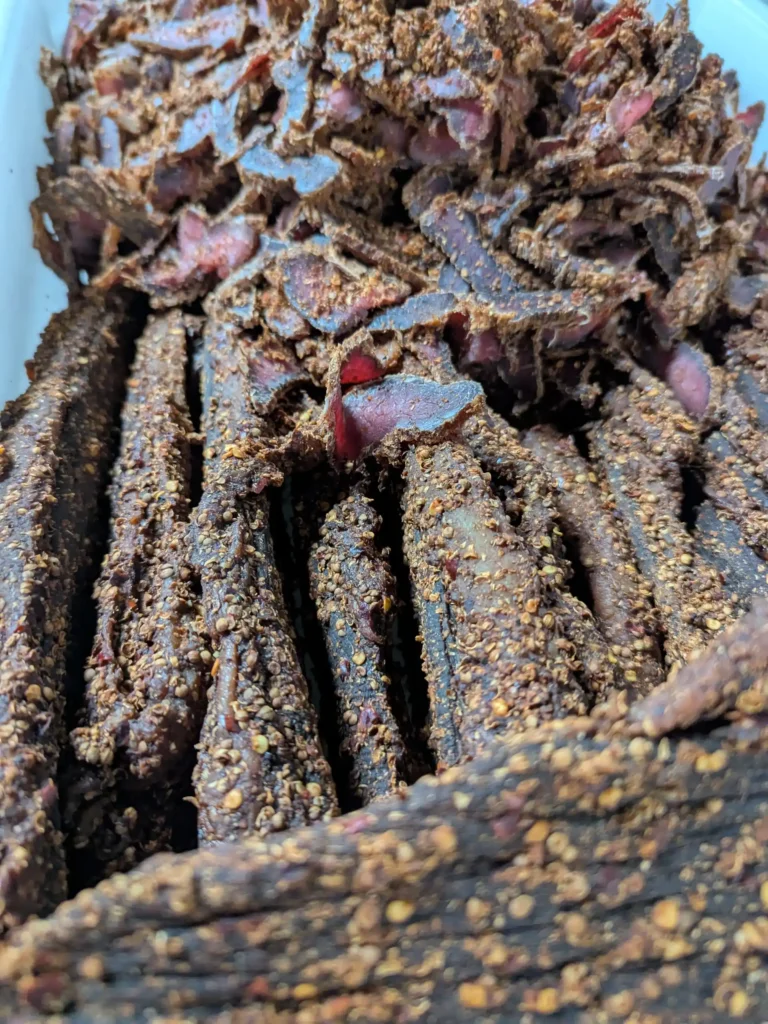The History of Biltong
For centuries before settlers arrived at the shores of Southern Africa there were two groups of people that inhabited the land. These groups were the San and Khoikhoi, commonly referred to as the Khoisan.
The Khoisan were a group of skilled hunter/gathers. They were also nomadic farmers that lived at one with nature. This skill and knowledge allowed them to live off the land. Part of their vast knowledge was the preservation of meat. This preservation was done through a curing process that involved using salt and hanging the meat to dry. With the arrival of European settlers, this process was refined by adding vinegar and spices before the meat was hung to dry.
The name “Biltong” was given by Dutch settlers.“Bil” means meat and “tong” means strip. The word Biltong refers to a strip of meat.
This cured form of meat in Biltong form played an important role in travel. It was long-lasting and provided essential protein in a daily diet.
Through the years Biltong has become an integral part of South African culture. It can be found in every supermarket or butchery in every town. Biltong has now spread to many other countries and is now consumed as a high protein snack.

Is Biltong healthy?
As can be seen from “The History of Biltong” above, Biltong had been around for centuries. The techniques used when making Biltong, which have not changed much in the last few hundred years, is simple enough to even make this tasty snack at home!
Biltong was not developed in a lab and is not some new age ultra-processed invention. Biltong is made from beef, vinegar, and spices, then air-dried
over time to preserve its flavor and nutrients. This healthy High Protein snack can be eaten in place of nuts, chips or any other processed snack food as a healthy alternative.
Due to this simple approach, no artificial preservatives or
unnecessary additives are found in Biltong. All we provide is high-quality dried Beef that consists of almost 50% Protein whilst containing B Vitamins, Creatine,
Iron, Potassium, Magnesium, Zinc and much much more! This makes Biltong the perfect snack food for any Carnivore, Keto, Paleo or High Performance Diets!
Biltong is created by naturally curing and air drying the Beef, varying from Beef Jerky which is a cooked (dehydrated at temperature) product. Realistically Biltong would be closer in comparison to Prosciutto but made with Beef not Pork. Completely dry Biltong is shelf stable but Biltong is rarely eaten completely dry due to texture preferences. We therefor highly recommend consuming the product in a timely fashion or refrigerating any overflow for later consumption.
In summary, Biltong is one of the cleanest, healthiest, most satiating snacks you
can eat. Our Biltong being high in protein, free from additives & preservatives , and packed with nutrients that support overall health. Adding to the health aspects, our Biltong is also moderate to low in Sodium by comparison, with each 57g (1/8LB) serving containing approximately 15% of the Daily Value per the FDA.

The King of Biltong (King_of_Biltong)
Anton transitioned from a career in the I.T. field to the Food industry as he has always had a passion for preparing and serving good food. Coming from a family with a tradition of home made cooking and baking, he always seems to find himself in the kitchen preparing some kind of food. After his wife Nicole hinted at him to start something in the Food industry for a few years, Anton’s African Cuisine was born in 2018. Anton then found a premises and started building the location, launching Anton’s as a Restaurant mid 2019. This change required a steep learning curve as the Food service industry was completely new to both Anton and Nicole. Having had their 3rd child at the end of 2019, with the business expanding, Nicole left her job in the Medical field to join Anton beginning 2020. Shortly after this the world as we knew it, changed forever with the global shutdowns.
Now with the entire family involved in the business and everything shut down, Anton started working on alternatives to dining in as take out and “cook at home” were the only options allowed. Anton’s changed from Anton’s African Cuisine to Anton’s Meat & Eat and started supplying Breads & Baked goods, various flavors of Meat Pies, Farmer’s Sausage (Boerewors), Ready to heat & eat Meals etc. Of course this also included an increase in demand for Biltong. Anton needed to quickly scale the meat production in order to keep up with demand for Biltong. Initially only a small percentage of the overall business sales came from Biltong, but due to the sudden increase in demand for take home, easy to prepare meals and ready to eat snacks, the demand increased exponentially due to the quality of the products he produced.
Very soon Biltong became the center point of the business as Anton seems to have perfected the taste and texture of his Biltong. This increase in demand and with online sales growing, required an expansion in production and supply. Land of Biltong was born in 2021 to serve our growing Biltong community!
In 2024 we acquired the URL for Biltong USA i.e. www.biltongusa.com which had great synergy with our main URL for Anton’s USA i.e. www.antonsusa.com where we were already serving the online community. We started transitioning to Biltong USA and Anton’s USA in order to streamline our brand marketing and hope to finalize the branding in 2025.
You can follow the King of Biltong on social Media:
Facebook – King_of Biltong Instagram – King_of_Biltong X – King_of_Biltong

